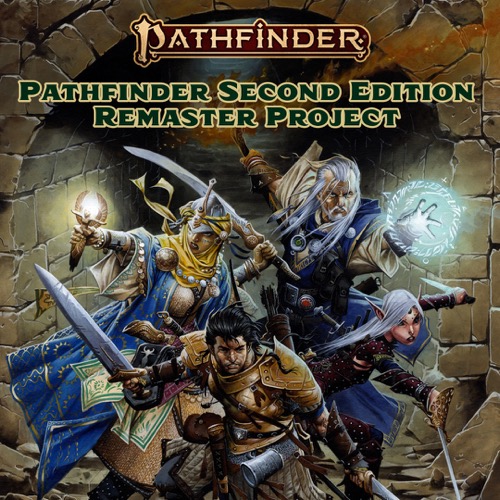Hi, this is Landon! As Halloween and the Remaster approaches, one question burns in our minds: who’s going to torch all these undead while simultaneously healing the entire party? As you can probably guess, that’s still going to be the party’s cleric, but let’s dive into some changes.
The cleric remains defined by their god, so before we get into the cleric, we should talk about the Remaster’s changes to deities and the cosmos. While the Remaster sees the removal of the nine alignments, edicts and anathemas still provide descriptions of a god’s desires and prohibitions to guide their followers’ behavior at a much finer level than alignment. But there’s still an endless struggle over the souls of the planes. The new system of divine sanctification (whether holy or unholy) represents a dedication to join that fight. Some gods now allow for sanctification—even when serving a goddess like Sarenrae who rose through the angelic ranks, joining her in the fight is ultimately a personal choice—where some gods now require that their clerics swear allegiance actively, like Asmodeus and Iomedae.
Alignment damage used to be a major tool here, but it sometimes got in the way of the cleric’s story. A cleric of Lamashtu might have dealt evil damage to scatter those standing up against the Mother of Monsters, but that often didn’t reflect the god’s will. Some gods were neutral, and all gods had enemies who opposed to their beliefs but weren’t of an opposite alignment. The Remaster’s new spirit damage type lets gods’ wrath manifest much more broadly, harming anything with a spirit, down to oozes that need to be scoured away. Clerics who undergo divine sanctification can infuse many of their spiritual abilities with holy or unholy power, so a divine lance cast by a holy character will still damage almost anyone, but it will also trigger the weaknesses of demons and devils. On the flip side of the coin, divine wrath excludes the allies who are helping a cleric do their god’s work, even if the alliance is a little peculiar.
Beyond these changes, we also took the opportunity to smooth out some rough edges. All clerics will see their divine font simply give them a number of bonus heal (or harm) spells regardless of their Charisma score, giving clerics a little more flexibility in how they allocate their attributes. The warpriest got improved weapon proficiencies where it could, raising martial weapons to expert at 7th level and their deity’s favored weapon to master at 19th. Along with Focus Point recovery becoming a bit easier for everyone in the Remaster, quite a few domain spells were improved or replaced, like pulse of civilization now giving wide access to the lore of nearby cities rather than one public fact and ignite ambition working as a reaction that the target notices only on a critical success.
A lot of the remastered classes have gotten a few new feats to help tell their stories better. Even with its changes, the cleric didn’t get left out on this front. As a powerful cleric, your god might protect you so dearly that they punish those who harm you, or you might reinforce your shield with the strength of your divine font. But there are also smaller miracles, like blessing the area around you to heal your allies out of combat or presenting your religious symbol to protect against the world’s varied hardships.
Raise Symbol [one-action] — Feat 4
Cleric
Requirements You are wielding a religious symbol.You present your religious symbol emphatically. You gain a +2 circumstance bonus to saving throws until the start of your next turn. While it’s raised, if you roll a success at a saving throw against a vitality or void effect, you get a critical success instead.
If the religious symbol you’re raising is a shield, such as with Emblazon Armaments, you gain the effects of Raise a Shield when you use this action and the effects of this action when you Raise a Shield.
Sacred Ground — Feat 4
Cleric, Consecration, Divine, Exploration
Prerequisites harmful font or healing font
Frequency once per 10 minutesYou pray continuously for 1 minute to call a subtle shadow of your deity’s realm over a 30-foot burst centered on you. It lasts for 10 minutes, and a creature that remains in the area for the entire 10 minutes regains Hit Points equal to your level.
If you have a healing font, this activity has the healing and vitality traits and heals living creatures. If you have a harmful font, this activity has the healing and void traits and heals undead creatures (or other creatures with void healing). Clerics with Versatile Font can choose either or both. It can’t damage creatures in any case.
Even my personal favorite cleric feat, Channeled Succor, spent some time in the fires of the Remaster to rise again as Restorative Channel, which interacts with the new, broader curative spells like cleanse affliction and clear mind. I’m stoked to have a new toolbox to channel all my new healing goodies. Especially with those spells all still helping when the counteract check doesn’t quite come through, it’s a good time to be freeing your friends from vexing conditions.
I hope you enjoy all these new options next month when Pathfinder Player Core is released. In the meantime, may your injured party be surrounded by a horde of low-level undead.
Cheers!
Landon Winkler (they/them)
Developer
The Cleric Remastered
Tuesday, October 24, 2023





